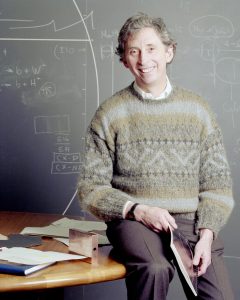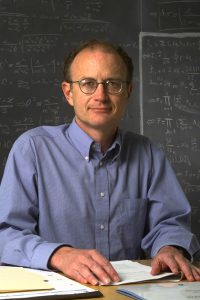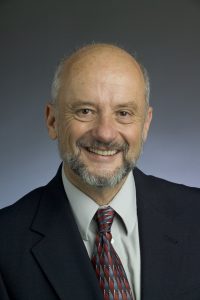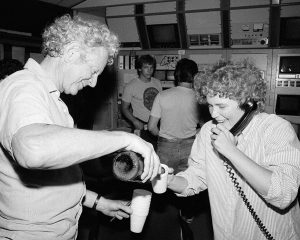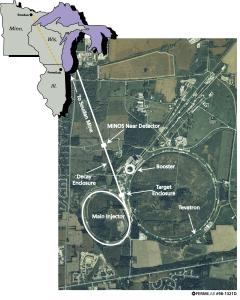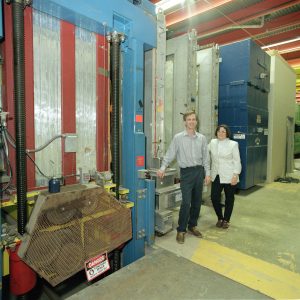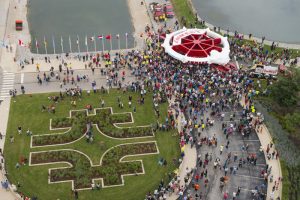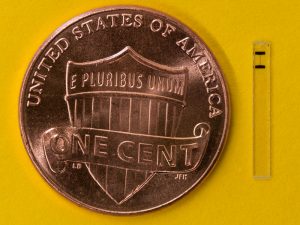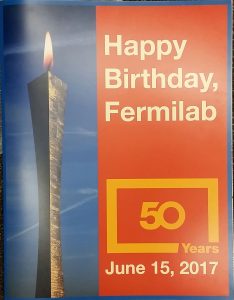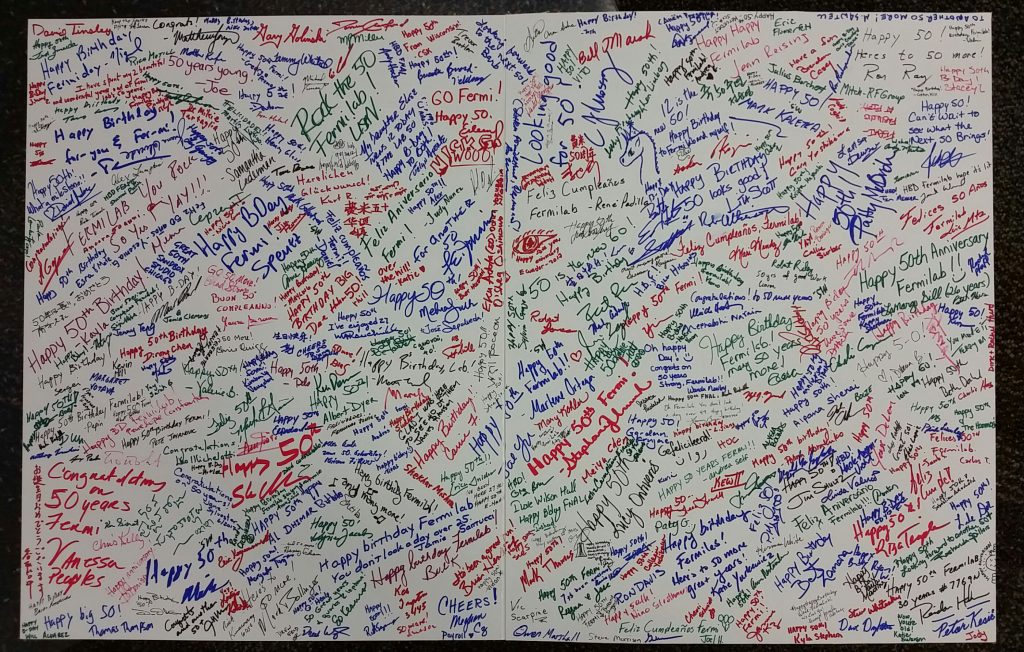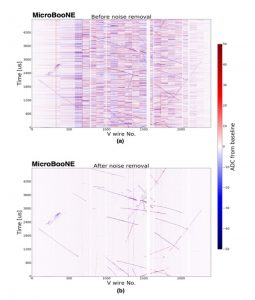
This two-dimensional event display shows the raw signal (a) before and (b) after offline noise filtering. Clean event signatures were recovered once all excess noise was removed.
If you have ever tried to watch a movie or listen to music on a plane, then you know the problem well: The roar of the engines makes it difficult to hear what’s being piped through the speakers — even when those speakers are situated in or on your ear. It’s great that we have noise-canceling headphones that can provide a more enjoyable listening experience. High-frequency sound waves are filtered because of the very structure of the headphone. Low-frequency sound waves are filtered by a process called destructive interference: The headphone’s sound waves are created 180 degrees out of phase with the intruding waves — those of the airplane engines — and the two waves cancel each other out. As a result, the listener can focus on the sounds he or she wants to hear.
In a similar manner, at the MicroBooNE detector we identify and filter out several excess noise sources at both high and lower frequencies. The primary component of the MicroBooNE detector is the liquid-argon time projection chamber (LArTPC) — a large, horizontal-silo-like vessel filled with liquid argon. Scientists make measurements of the particles that result from the collision of a neutrino with an argon nucleus. These particles leave in the argon a trail of electrons, which drift toward two planes of wires —8,256 of them — in the LArTPC. That information travels as current through the wires, and researchers use the information to learn more about the neutrino that triggered it.
The current on each wire is amplified and shaped by custom low-power, low-noise circuits immersed in the liquid argon. The low-noise operation of readout electronics in a LArTPC is critical to properly extract the distribution of charge deposited on the wire planes of the TPC. Using data from the first year of MicroBooNE operations, researchers identified several distinct types of TPC noise, which exceeded expectations for the types of noise inherent to the electronics.
With the support from the entire collaboration, the analysis team developed an offline noise filter that eliminates most of the excess noise while achieving excellent signal preservation. The resulting two-dimensional event display for a signal from one data event is shown in the figure both before (panel (a)) and after (panel (b)) offline noise filtering. The team recovered clean event signatures after subtracting all identified noise sources. The residual electronics noise is consistent with the cold electronics design expectations and is stable with time and uniform over the functioning channels. This noise level is significantly lower than previous experiments that used warm front-end electronics.
In summer of 2016, the collaboration additionally performed several hardware upgrades, with new components from Brookhaven National Laboratory and technical support from Fermilab, to mitigate the two largest sources of excess noise. After the successful upgrade, the residual excess noise was largely removed. This result has been submitted to the Journal of Instrumentation and can be found on arXiv.
In a talk on the topic, Jyoti Joshi of Brookhaven, one of the papers co-authors, noted that the experience accumulated during the first year of data taking proved to be critical in the optimization and operation of the MicroBooNE TPC and is already proving useful in informing the design of future LArTPC detectors. There will be a wine and cheese seminar at Fermilab covering the first year of MicroBooNE operations on July 28, so come learn all about it.
If in a few years you happen to travel down Highway 85 in the Black Hills near Lead, South Dakota, you will find yourself passing beneath a new, narrow beam-like structure stretching across the road overhead.
You’ll be crossing under part of a conveyor system that will be used to transport rock from nearly a mile underground at the former Homestake gold mine — now the Sanford Underground Research Facility — to an enormous open pit on the surface as underground space is carved out to house a giant particle detector.
Scientists from the international Deep Underground Neutrino Experiment (DUNE), an experiment hosted by the U.S. Department of Energy’s Fermi National Accelerator Laboratory, will build and use the mammoth detector to study particles called neutrinos. Understanding these particles is expected to lead to a deeper knowledge of how our universe is put together.
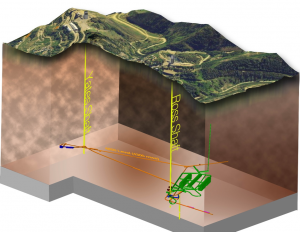
The North Alabama Fabricating Company has been contracted to design and fabricate a rock conveyor to help remove rock from the former Homestake Mine. This effort is to make way for a giant particle detector for the international Deep Underground Neutrino Experiment. The detector will be situated nearly a mile underground. Image: Sanford Lab
On June 28, Fermi Research Alliance LLC, which operates Fermilab, signed a contract with North Alabama Fabricating Company to design and fabricate the pipe conveyor to be installed at Sanford Lab. The contract supports the excavation for the Long-Baseline Neutrino Facility (LBNF), the facility that will house and support DUNE.
“The fabrication and installation of the pipe conveyor will be a major step toward LBNF excavation,” said Mike Headley, executive director of the South Dakota Science and Technology Authority, or SDSTA, which owns and operates Sanford Lab. “It’s an exciting milestone, and the SDSTA is proud to support the LBNF team on this project.”
Fermilab and Sanford Lab staff expect conveyor installation to begin in mid-2018 and continue for six months. Rock removal is expected to take about three years once the conveyor begins operating.
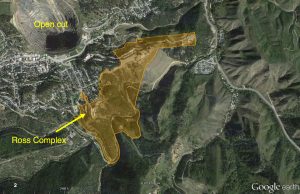
The rock conveyor will transport rock excavated from the former Homestake Mine to a nearby open cut. Image: Sanford Lab
“The conveyor will transport about 800,000 tons of rock — approximately equal to the mass of eight Nimitz class aircraft carriers,” said retired U.S. Navy admiral Chris Mossey, who is now the LBNF project director at Fermilab.
Like a giant futuristic supermarket checkout lane, the rock conveyor will move rock over a stretch of 3,700 feet while containing dust and debris.
The conveyor path will take advantage of a long, existing tunnel carved out during Homestake’s gold mining days in the 1930s. The conveyor will start 175 feet underground, make its way to the surface, and continue high above ground until it arrives at the pit, called an open cut, which is roughly two miles wide and 1,200 feet deep. In fact, miners used a similar machine in the 1980s to transport rock away from the open cut as they looked for gold.
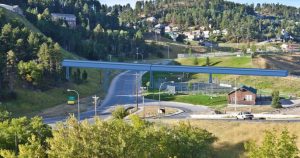
This is a conceptual illustration of the aboveground portion of the rock conveyor. Image: Sanford Lab
LBNF project members have kept in close contact with the city of Lead and its residents regarding rock-handling options, as well as with the State Historic Preservation Office to ensure that cultural aspects of the site are understood and respected. The communication will continue as the design evolves.
“The design team has worked hard to come up with the right system,” said Fermilab’s Elaine McCluskey, LBNF project manager.
Excavation for the DUNE detector caverns is expected to be complete in early 2022.
Editor’s note: The amount of rock to be excavated for LBNF at the South Dakota site mentioned in this article was updated on May 2, 2019.
July brought Fermilab three new directors, two discovery announcements and one big, red ring. Read on for more July historical milestones.
In July 1989, John Peoples replaced Leon Lederman as Fermilab’s director. Peoples had joined the lab in 1971. He served as head of the Research Division and the Accelerator Division and oversaw the Antiproton Source, a key part of the Tevatron.
On July 1, 1999, Michael Witherell became Fermilab’s fourth director. He had worked at Fermilab on an experiment studying charm quarks in the 1980s and was a professor at the University of California, Santa Barbara, when he accepted the Fermilab directorship.
Pier Oddone became Fermilab’s fifth director on July 1, 2005. Originally from Peru, he was serving as deputy director at Lawrence Berkeley National Lab when he became Fermilab’s director and won the 2005 W.K.H. Panofsky Prize in experimental particle physics.
The Tevatron surpassed its design energy of 500 GeV within 13 hours of the first attempt to accelerate the beam. It reached a world record proton beam energy of 512 GeV on July 3, 1983.
On July 4, 2012, scientists with CERN’s CMS and ATLAS experiments announced the discovery of the Higgs Boson, a particle that had been predicted by theorists and is responsible for giving other particles mass. Fermilab plays a significant role in the CMS experiment, and many Fermilab scientists contributed to the discovery.
MINOS, the Main Injector Neutrino Oscillation Search, was Fermilab’s first long-baseline neutrino experiment. It was designed to observe the phenomenon of neutrino oscillations, an effect that is related to neutrino mass. The groundbreaking for the MINOS detector hall in the Soudan Mine near Tower, Minnesota, was held on July 20, 1999, marking the beginning of the lab’s transition from the Tevatron era to the neutrino era.
The Fermilab DONUT collaboration, which recorded data with a Tevatron fixed-target experiment in 1997, announced the first direct evidence for the tau neutrino on July 21, 2000.
Fermilab and Brookhaven National Laboratory transported a 50-foot-wide particle storage ring from Brookhaven in Long Island, New York, to Fermilab so it could be reused in Fermilab’s Muon g-2 experiment. The move began on June 22, and the ring traversed over 3,200 miles of land and water on its 35-day journey. About 3,000 people came to Fermilab on July 26, 2013, to watch it arrive.
Dark matter particles have escaped detection for decades, despite scientists’ best efforts. Now, scientists at the Department of Energy’s Fermi National Accelerator Laboratory and the University of Chicago are planning to search for these invisible particles with cutting-edge quantum sensor technology.
Researchers are currently working to prove that the technology will work as expected. Early work has been promising, and the scientists have secured a $642,000 grant from the Heising-Simons Foundation to support graduate students and over $2 million from Fermilab’s Laboratory Directed Research and Development program for equipment.
Cosmic hide-and-seek
Scientists know that dark matter exists because we can see its gravitational effects on the cosmos. The pull from dark matter affects how stars revolve in galaxies and even determines how galaxies are spread out across the sky.
In spite of its clear influence on the cosmos, scientists still don’t know what dark matter is made of.
One dark matter candidate is a theorized, fundamental particle known as the axion. Sometimes said to be named after a laundry detergent because it “cleaned up” problems in physics, the axion would be an incredibly lightweight particle that only weakly interacts with other matter. Still, with enough of them clumped together, axions could act as the dark matter that invisibly shapes our universe.
Scientists search for dark matter axions by converting them into particles of light, called photons.
“What you need is a very, very dark box,” said Aaron Chou, a Fermilab physicist who is leading the project.
According to theory, in a strong magnetic field, axions can convert into photons, which can be used as a proxy for the axions’ existence. If the magnetic-field-infused box — called a cavity — is dark enough, the scientists can observe the photons.
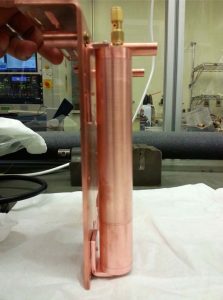
Scientists at Fermilab and the University of Chicago will look for dark matter axions converting into photons inside a sealed copper tube called a cavity. Photo: Akash Dixit
Chou’s prototype cavity is a copper tube about the size of a wine bottle. Current experiments such as the Axion Dark Matter Experiment at the University of Washington use larger cavities that are several feet in diameter.
“Traditionally, you would punch a hole in the box and stick in an antenna. That antenna is how you would read out the photons,” Chou said.
Like an FM radio, the scientists use a receiver to “listen” for axions in the cavity. By adjusting the cavity, scientists can vary the frequency — or “tune” — of the cavity and search for clear evidence of axion-to-photon conversion.
“It’s like you’re driving out in the middle of farmland, and there are hardly any radio stations at all. You’re tuning and you hear static,” Chou said. “You turn the dial a little more, you hear static, and you keep on going. Can I hear a radio station? No, just more static. You step through frequencies one at a time. That’s how the search works.”
To minimize unwanted signals, the cavity must have as few photons from other sources as possible. In other words, it has to be unimaginably dark. As it turns out, getting something to be very, very dark is very, very difficult.
A shot in the dark
To create a dark cavity, scientists eliminate all external sources of light. But even when an object is perfectly sealed, photons are still present: All matter emits photons if it has a temperature higher than absolute zero. This phenomenon is the reason that hot metal glows. Cooler objects don’t glow because the photons they emit are in the nonvisible spectrum of light.
“The colder you make something, the less likely it is to be populated by photons,” said Akash Dixit, a graduate student at the University of Chicago working on the project. “There’s exponentially less light the colder it is.”
Axion experiments are cooled all the way down to less than 1 kelvin using liquid helium. But even at these frigid temperatures, where there is virtually no noise from heat, direct measurements of particles will still have unwanted noise.
An inconvenient reality of the quantum world is that the very act of taking a measurement creates uncertainty.
“Every time you make a measurement, you’re giving the system a kick,” Chou said. “Doing that introduces an intrinsic noise into the results of the measurement.”
Normally, this isn’t a big problem. If there are millions of photons, the measurement’s uncertainty is negligible. But when scientists are looking for just one photon, things get tricky.
Chou and his team plan avoid the “kick” itself, which they can do by measuring the photons indirectly.
Q is for quantum
As a graduate student, David Schuster was a member of the first team to detect a microwave photon using a quantum sensor. Schuster, now a professor at the University of Chicago and a leading expert in quantum sensors, asked his advisor at the time if their breakthrough had any use for astronomy.
“I asked him if we could use it to detect some astronomical phenomenon,” he said. “He said, ‘Only if you can find photons that magically appear inside a sealed cavity.’”
Years later, Schuster and Chou were talking, and the two realized that they could help one another. Chou needed to observe photons appearing inside a sealed cavity, and Schuster knew exactly how to detect them.
Quantum sensors are devices that respond to incredibly small changes in electrical fields, allowing them to detect a single photon.
Because the sensors must be able to detect subtle phenomena, their construction requires a delicate touch.
Dixit uses software to design the sensors, which are then assembled using precision machines. Thin layers of material such as aluminum and niobium are added on top of one another and then engraved with lasers. Hills and valleys from these engraving and layering processes result in the sensor. The end product fits on a tiny glass slide smaller than a thumbnail.
The specially tuned quantum sensor, sitting just outside of the magnetic field that fills the dark cavity, can pick up on the presence of a photon in the cavity.
“The quantum sensor can be thought of as a guitar string that plays a particular note,” Schuster said. “Like a guitar, where pressing on a fret tunes the note by a set amount, each photon in the cavity shifts the frequency by a known amount.”
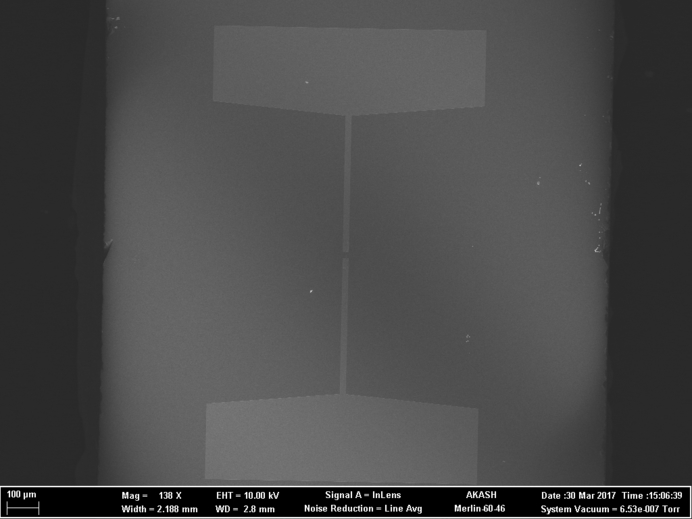
Quantum sensor GIF. See the lower left corner of the image for magnification values. Fully zoomed out (at magnification 138X), the GIF shows a quantum sensor made up of an antenna and Josephson junction, allowing scientists to “listen” for evidence of a axion converting into a photon. The large paddle-shaped regions are made of niobium and function as the antenna. Attached to the antennae are two layers of aluminum that look like funnels (magnification 1.44K and 4.39K X). This connects the Josephson junction to the surroundings. Finally, fully zoomed in (at magnification 20.44 K and 62.83 K X), the GIF shows the Josephson junction, shaped like a cross. Both pieces of the cross are made of superconducting aluminum and are separated by a thin layer of aluminum oxide (roughly 10 atoms thick). Images: Akash Dixit
The key to the sensor is the Josephson junction, formed by two overlapping strips of superconducting material only a few hundred nanometers wide — two thousandths of the width of a human hair. Pairs of electrons can hop from one side of this junction to the other.
When a photon is in the cavity, its presence changes how often — the frequency — electrons cross the Josephson junction.
Using a device with perfect pitch, the researchers will be able “hear” this change in frequency. If the change in pitch is just right, they’ll have detected a photon created by an axion.
By avoiding the “kick” of direct measurement, the scientists can indirectly and nondestructively measure the photons with lower uncertainty than typical of the quantum world.
“In simpler terms, we’re taking a device on a piece of glass and sticking it inside a cavity to ask the question, ‘Is there a photon or not?’” Chou said.
If there is a photon, then scientists could have observed an elusive axion.
Chou and Schuster plan to eventually scale the project up to have a better chance of detecting axions, using multiple cavities and more powerful magnets.
If the design works as promised, the research may graduate from project to fully funded experiment.
“Every single thing that’s part of the official lab program right now did not start out as an official thing,” Chou said. “It started out as some people with an idea, who developed that idea and had preliminary results that showed the idea wasn’t crazy.”
“Happy birthday, Fermilab!”
Those well-wishes were recently offered from Secretary of Energy Rick Perry (beginning at 1:30), Congressman Bill Foster and Congressman Randy Hultgren on the occasion of Fermilab’s 50th anniversary.
Congress also recognized Fermilab’s 50th anniversary through two resolutions, in the House and the Senate.
Anniversary recognition came from our partner laboratory CERN as well, specifically from the CERN Staff Association.
Fermilab received many personal birthday cards from around the world. View them on our Facebook gallery.
And of course, Fermilab staff and users were enthusiastic about registering their birthday wishes by signing a giant birthday card on June 15, the anniversary date of day lab employees first came to work.
Thanks to our Washington, D.C., officials, to our friends and followers from around the world, and to our very own Fermilab staff and users for the birthday congratulations. May we enjoy another 50 years of science discovery.

